
Magnetism (O-level physics)

MAGNETISM
This is the ability of substances to attract and/or to repel others.
A magnet is a piece of metal which is able to attract another magnet or a magnetic material.
Lodestone is a naturally occurring magnet. A magnet exerts magnetic forces on magnetic materials.
The magnetic forces are:
- Forces of attraction.
- Forces of repulsion.
Uses of magnets
- In construction of cycle dynamos, telephones, loud speaker, electric meters, current measuring instruments.
- To remove metal splinters from oil engine
- For door closures
- Electric bell
- Magnetic ink
- Computer memory cards.
- Electric motor
- Magnets are used in hospitals to remove iron pieces from the eye of patient.
- Making magnetic tapes used in audio and video recorders.
Properties of a magnet
(a) It attracts other pieces of metals.
- Materials attracted by magnets are called magnetic materials
- Materials strongly attracted by magnets are called ferromagnetic materials such as iron, nickel steel, cobalt.
- Materials that are not attracted by magnets are non magnetic materials, e.g. copper, brass, aluminium, wood and plastics
- Nonmagnetic material can either be diamagnetic or paramagnetic materials
- Diamagnetic materials whose atoms have no permanent magnetic dipole moment but when placed in a magnetic field, a weak magnetic dipole moment is induced in the direction opposite the applied field; e.g., copper, bismuth and benzene
- Paramagnetic materials that are weakly attracted to magnets. e.g. platinum
(b) It possesses magnetic poles– the North Pole and South Pole at the ends of a magnet. These are places where magnetic forces appear to be concentrated.
(c) A freely suspended magnet rests in the North-south direction
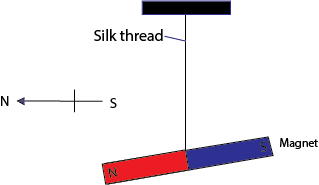
Explanation; This is because the earth is a magnet having its south pole in the northern hemisphere and its north pole in the southern hemisphere so there is attraction between the poles of freely suspended magnet and the earth’s magnet.
Laws of magnet
- Like poles of magnets repel; g. when a north pole is brought near a north pole or a south pole brought near the south, repulsion occurs.
- Unlike poles of magnet attract g. a north pole brought near the South Pole attraction will occur.
Testing for polarity of a pole
A known pole of magnet is brought near the ends of a material suspected to be a magnet. If repulsion occurs then that end of material is a like pole. The poles of a given magnet or magnetized material are tested by repulsion occurring between poles of a known magnet and that of the material whose polarity is to be tested.
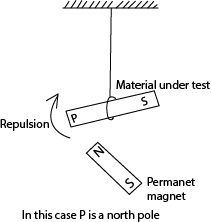
NB: Repulsion is the only a sure test for polarity because repulsion only occurs due to like poles of magnets. While attraction is not a sure test because attraction can either result from unlike poles of magnets or from magnet and Ferromagnetic material which is not magnetized.
Magnetic domain theory
A magnet is made us of tiny molecular magnets called dipole arranged in groups called magnetic domains, lined up with their N-poles pointing in the same direction.

In nonmagnetic materials, the domains are randomly mixed and their magnetic effect cancel each out.
Magnetization
This is a process by which randomly arranged molecular magnet of a ferromagnetic material are aligned to point in one direction.
Methods of magnetization
These include:
- Single touch method.
- Double touch method.
- Electrical method using direct current (d.c.).
(a) Single touch or single stroke method

A steel bar (Ferromagnetic material) is stroked several times from end to end using a bar magnet. The stroking is done in the same direction and using the same pole of bar magnet. A becomes a north pole while B becomes a south pole.
Molecular magnets explanation
The stroking of the magnet pulls the randomly molecular magnets to face in one direction thus material becomes magnetic.
Disadvantage of single stroke method
The magnet produced has one pole nearer to the end as compared to the other pole
Identification of a pole
The pole of the bar magnet being used for stroking should be the same pole induced at the end of the steel bar from where stroking starts.
(b) Double touch method or double stroke method

This uses two bar magnets placed at the centre of the steel bar with unlike poles as in the diagram. The stroking begins in the middle of the steel bar and ends at the opposite ends. The magnets are raised high at the end of each stroke before another one begins. This prevents reversing the acquired magnetism.
Molecular magnet
As stroking is done, the molecular magnets are pulled to face in one direction therefore creating poles at the ends of the steel bar.
Advantage of a double touch method over a single touch method
All poles are at both ends while for single touch method one pole is nearer to end than the other.
Disadvantages of double touch method over a single touch method
Double touch method is more expensive and tiresome.
(c) Electrical method
The steel bar to be magnetized is placed inside a solenoid connected to the cells.
When direct current is switched on for some time, the bar will be magnetized
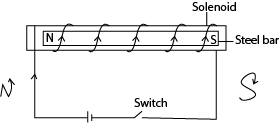
Note that with a.c. current the bar is not magnetized
Polarity of steel bar
The polarity of the steel bar depends on the direction in which the current is flowing. Current flows from positive to negative, so if on looking at the end of solenoid, current is flowing in a clock wise direction, that end will be South Pole but if it is flowing anti clockwise the end will be a north pole.
(e) Induction method
When a magnetic material is kept close to a magnet for long time it gets magnetized.
Magnetic saturation
This is the maximum level of magnetization when the resultant magnetic axes of all domains in magnetic material are aligned with the magnetizing field.
Demagnetization
Demagnetization is the process through which magnets lose their magnetism
Demagnetization result in scattering molecular magnets to face in randomly.
Methods of demagnetization
(i) By Heating:
Heating a magnetized material makes it loses its magnetism. This is because the temperature rise causes the vibrations of molecular magnets to become so great that their ordinary arrangement is destroyed.
(ii) By hammering:
Hammering a magnetized material placed in east-west direction, makes it loses most of its magnetism. This is because when a magnet is hammered, the vibrations of the molecular magnets increase which result in random arrangement.
(iii) By electrical method using alternating current
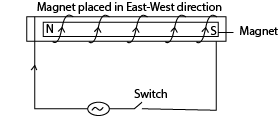
Here an alternating current is supplied to the solenoid in which the magnet is placed in east-west direction.
The alternating current (a.c.) causes the molecular magnets to change from orderly to random arrangement as current changes direction of flow every half cycle.
The demagnetized magnets should be removed from solenoid and stored along east- west direction to avoid magnetization due to earth’s field.
Storing magnets
Small pieces of soft iron called keepers are placed across opposite poles of two bar magnets

These iron keepers become induced magnets and their poles neutralize the poles of the magnets. This ensures that there is no magnetic loss.
Soft and hard magnetic substances
Soft magnetic materials are substance that are easily magnetized and easily lose magnetism, e.g. soft iron.
Soft magnetic materials are used in making soft-iron core in transformers, dynamos, e.t.c.
Hard magnetic material are materials that are difficult to magnetize but retair their magnetism for long, e.g. steel.
Hard magnetic materials are used in loud spears.
Magnetic field
A magnetic field is a region around a magnet in which magnetic force is experienced.
An experiment to determine the magnetic field pattern of bar magnet using iron fillings.
- A cardboard is placed on a magnet and iron fillings sprinkled on the cardboard
- On tapping slightly on the cardboard, the fillings arrange themselves along the magnetic lines
The figure below shows Iron filings attracted to a bar magnet to show the magnetic field.
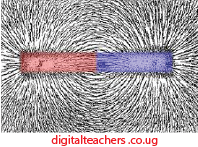
Magnetic field lines
They are lines of forces in magnetic field running from North to south poles of a magnet. The direction of these lines can be shown using a plotting compass.
Magnetic field patterns are shown below

NB: (i) Neutral point are places around magnets where the magnetic field flux is zero; i.e. no magnetic line pass through neutral point
(ii) The more crowded the field lines, the stronger the magnetic force
(iii) Magnetic shielding/screening is the protection of the object against external magnetic fields by enclosing it with soft – iron ring or box

The magnetic field lines are attracted to soft iron ring shielding the region enclosed by the ring or box from magnetic field
Application
Thick-walled soft-iron boxes are used to shield delicate and sensitive electrical instruments from external magnetic fields
The earth as a magnet
Suspending a bar magnet
When a bar magnet is freely suspended, it always come to rest in a north-south direction. This is because the earth is a magnet having its north pole in the southern hemisphere and South Pole in the northern hemisphere and these poles attract the poles of the freely suspended magnet, i.e.

Definitions
- Magnetic meridian is a vertical plane containing magnetic axis of a freely suspended magnet at rest under the action of earth’s magnetic field.
- Geographical meridian is the vertical plane passing through the axis of rotation of the earth
- Angle of dip /Angle of inclination: Angle of dip (inclination) α: Angle of dip is the angle that the axis of a freely suspended bar magnet makes with the horizontal when the magnet settles.
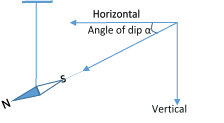
- Angle of declination is the angle between the earth’s magnetic and geographical meridians. Or the angle between magnetic north and true north.

Experiment to determine magnetic meridian
- A permanent bar magnet is suspended on a retort stand using a thread and allowed to settle.
- The vertical plane parallel to the magnetic axis represents the earth’s magnetic meridian

Magnetic flux pattern of a horizontal bar magnet in earth’s magnetic field
(a) South Pole, S, of bar magnet facing to north (attraction occurs)
(b) North Pole, N, of bar magnet pointing north (repulsion occurs)
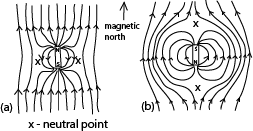
Magnetic flux pattern due to soft iron in earth’s horizontal magnetic field

Magnetic Effect of current
When current flows in a conductor placed near a compass needle, the needle deflects depending on the direction of current.
This shows that around a conductor carrying current, there is a magnetic field which depends on the direction of current.

The direction of magnetic field around such a conductor is obtained by right hand grip rule(RHGR)- with the thumb pointing along the direction of current, the direction of fingers gives the direction of the magnetic field
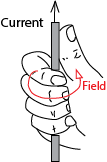
Magnetic field pattern due to current carrying conductors
(a) Straight conductor carrying current into or out of the paper

(b) Magnetic field pattern due to a coil
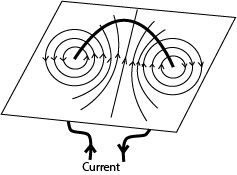
(c) Magnetic field pattern due to parallel conductors

F- is the force experienced by the conductors.
(d) Magnetic field pattern due to solenoid

Electromagnets
An electromagnet is a temporary magnet which acquires and loses its magnetism by switching on or off current.
It consists of soft iron core placed inside the solenoid.
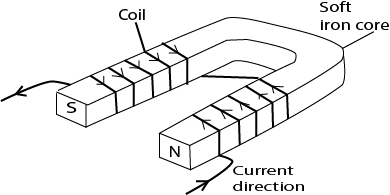
The strength of the electromagnet is increased by
- Increasing current in the coil
- Increasing number of turns (windings) of the coil
- Bringing poles closer
Uses of electromagnet
(a) Electric bell

- When the switch is closed, current flows through the circuit and the core become magnetized
- The iron armature is attracted towards the magnetized core causing hammer to hit the gong and produce sound but this breaks the contact and the circuit.
- When the circuit is broken, the iron core loses magnetism releasing the armature to be returned to the contact by the spring.
- Again the circuit is completed and the process repeats, the hammer making repeated sound.
(b) Telephone receiver
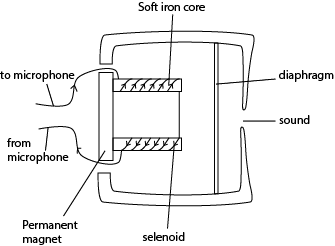
- The varying current from the microphone passes through the coil of electromagnets, soft iron core gets magnetized and pull the diaphragm to and fro depending on the current from the microphone.
- Vibration of the diaphragm produces sound
(c) Moving coil loud speaker
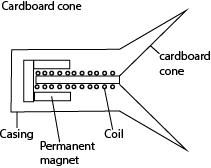
- When the varying current is supplied into the coil, the coil is magnetized and vibrates backwards and forwards, with the same frequency as that of the current.
- The motion of the coil in turn causes the cone to vibrate, causing the surrounding air to vibrate, and sound is produced.
(d) Relay switch

- This is a switch that is operated by an electromagnet.
- When current flows in the coil, soft iron is magnetized and attracts iron armature which closes the contact at C.
- This completes the circuit connected to DE and current flows in it.
Current carrying conductors in a magnetic field
When a current carrying conductor is placed between poles of a permanent magnet, it experiences a force F.
The strength of this force depends on
- Strength of the magnet field (B)
- Length of the conductor (L)
- Current (I) through the conductor
i.e. F= BIL
The direction of the force is determined by Fleming’s left hand rule- with the first finger pointing to the magnetic field, second finger in the direction of current, the thumb in the direction of the force (motion)
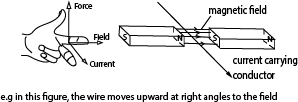
Magnetic field pattern of a current carrying conductor placed in
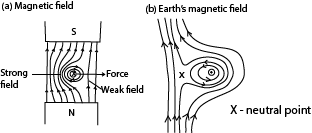
Electromagnetic Induction
If a wire is moved through a magnetic field in such a way that it cuts the magnetic lines of force, a voltage is created across the wire. An electric current will flow through the wire if the two ends of the wire are connected by a conductor to form a circuit.
This current is called an induced current, and the induction of a current in this manner is called electromagnetic induction.
It does not matter whether the wire moves of the magnetic field moves provided the wire cuts through lines of force, a current is induced.
This can be observed when
(a) A straight wire AB connected to the galvanometer at right angle to the field
When the wire is moved downwards, the meter deflects to the right. This shows that the current is induced in the wire.
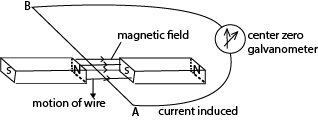
Note
- The relative motion of the wire in a magnetic field leads to induced e.m.f. hence current.
- The faster the motion of the wire, the greater the induced current. (Faraday’s law)
- The induced current leads to a force acting in the opposite direction to the motion of the wire (Lenz’s law)
- The direction of the induced current is determined by Fleming’s right hand rule (with the first finger pointing to the direction of the field, the thumb points in the direction of force (motion), then the second finger points in the direction of current.

(b) A bar magnet is brought towards the coil (solenoid) connected to galvanometer
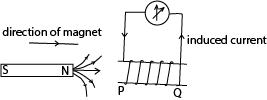
When a north pole is approaching a solenoid current is induced in it to oppose the incoming N pole of the magnet. Thus end P of solenoid becomes a north pole.
Note that the induced e.m.f. depends on
- Number of turns of the coil
- Area f the coil
- Speed of the magnet
- Strength of the magnet
(c) The simple d.c. electric motor

- When the coil is rotated, the magnetic field linking the coil changes and e.m.f is induced.
- When the coil passes the vertical position, the two halves of commutators change contacts with the brushes, e.m.f in the coil reverses but the direction of current in external circuit remains the same.
Note: due to the resistance, R, of the coil
- Power waster in the coil = I2R
- Power input (power supplied), Pin = IiVi
- Power output, Pout = IoVo = power supplied – power wasted =IV -I2R
- Efficiency of the motor =
Example1
The armature resistance is 4Ω. If it draws current of 10A when connected to a 200Vsupply, clculate the
- Power wasted
Power wasted in the coil, P = I2R = 102 x 4 = 400W
- Efficiency of the motor
Power input, Pin = IV = 10 x 200 = 2000W
Power output = IV – I2R = 2000 – 400 = 1600W

(d) c. generator
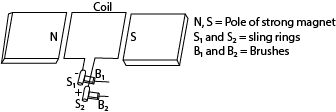
Mode of action
- The coils is turned with uniform speed in magnetic field.
- Because of change in magnetic field linking the coil, an e.m.f is induced in the coil.
The induced e.m.f varies as shown below

The coil, is in horizontal position, the rate of change of magnetic flux linkage is maximum, i.e. maximum induced e.m.f.
In vertical position, the rate of change of flux linkage is zero, i.e. zero e.m.f is induced.
Beyond the vertical position, induced e.m.f reverses because of change in direction of sides.
Transformer
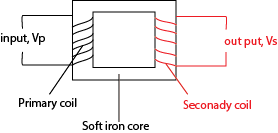
It consists of two coils, the primary coil and secondary coil, wound closely over one another on a laminated soft iron core
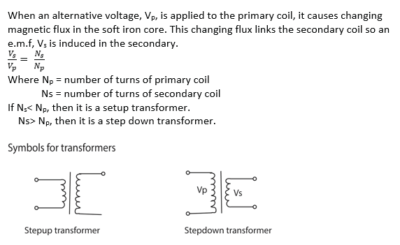
Power losses in a transformer
| Power loss | Minimized by |
| Heat in coils due to their resistance | Use thick copper coils of low resistance |
| Eddy current in soft iron core | Using laminates soft iron core |
| Leakage of magnetic flus | Winding the same part of the soft iron |
| Magnetic reversal in the coil due to changing magnetic fields | Using soft iron with low magnetic reversals |
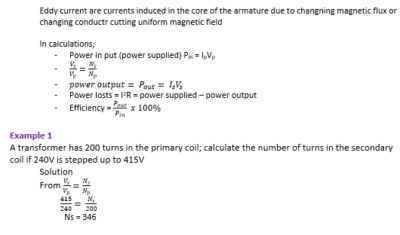
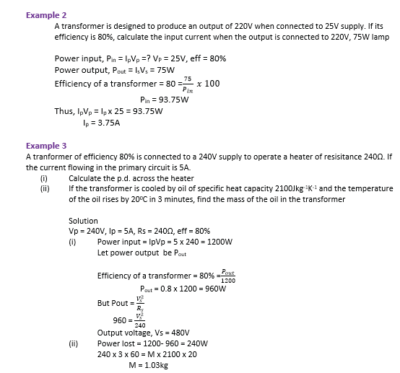
Power Transmission
Efficient power transmission requires a step-up transformer at the power generating station to rise voltage and decrease the current. This reduces power loss in the wires, since power loss = I2R where I is current and R is the resistance of the wires.
Later, appropriate step down transformers are than used to reduce the voltage for local use
Advantages of a.c. over d.c
- c. is tepped up or down easily
- c. can be transmitted over long distance
- c. can easily be converted to direct current
- c. is easy to generate
Please download PDF:magnetism o-level.docx
Please Subscribe to promote this website. Subscription is free
Share with a friend
Your comments are highly well come
Thank you so much

Download is not easy
How can I download the notes for that topics
Go to “digitalteachers.co.ug” browse ‘O-level physics’
Keep up the good work. Very current and useful notes.
They are going to help me a lot in my studies.
How can I ask any questions i may have regarding my understanding of any concept discussed here and in other topics of o level physics please
Thank you so much for making available the notes. God bless all hard working and inspiring teachers
ok, thanks
Good and well explained notes but how can I download
Good and explained but how can I download the notes
use digitalteachers.co.ug website under science subjects on the top bar menu
Good notes Sir, God bless you
You are the best of all.
Thank you very much dr
Great magnetism work
Keep up
I’m excited to see where you’ll go next. Industrial & Scientific